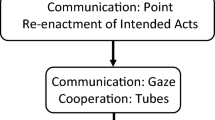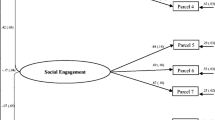Abstract
A reanalysis of data from an experimental study of autistic negativism is presented. Subjects were autistic, behavior-disturbed, or normal and ranged in age from 5 to 12 years. There were nine subjects per group. Experimental conditions consisted of a veral request for a verbal response, a nonverbal request for a nonverbal response, and a verbal request for a nonverbal response. Data were reanalyzed by dichotomizing subjects as either compliant or noncompliant on the basis of the number of correct responses; scalogram analysis was then performed on the dichotomized data. The children's responses to the messages formed a cumulative, unidimensional hierarchy based on the individual patterns of responses, with verbal requests for verbal responses eliciting the least compliance and verbal requests for nonverbal responses the most. Implications of the hierarchy for a developmental theory of autistic negativism and the relationship of task demands to compliance are discussed.
Similar content being viewed by others
References
Alpern, G. D. Measurement of “untestable” autistic children.Journal of Abnormal Psychology, 1967,72, 478–486.
Bettelheim, B.The empty fortress. New York: Free Press, 1967.
Boatman, M., & Szurek, S. A. A clinical study of childhood schizophrenia. In D. Jackson (Ed.),The etiology of schizophrenia. New York: Basic Books, 1960.
Caparulo, B. J., & Cohen, D. J. Cognitive structures, language, and emerging social competence in autistic and aphasic children.Journal of the American Academy of Child Psychiatry, 1977,16, 620–645.
Churchill, D., & Bryson, C. Q. Looking and approach behavior of psychotic and normal children as a function of adult attention or preoccupation.Comprehensive Psychiatry, 1972,13, 171–177.
Clark, P., & Rutter, M. Compliance and resistance in autistic children.Journal of Autism and Childhood Schizophrenia. 1977,7, 33–48.
Cohen, D. J., Caparulo, B., & Shaywitz, B. Primary childhood aphasia and childhood autism: Clinical, biological, and conceptual observations.Journal of the American Academy of Child Psychiatry, 1976,15, 604–645.
Cowan, P. A., Hoddinott, B. A., & Wright, B. A. Compliance and resistance in the conditioning of autistic children.Child Development, 1965,36, 913–923.
Creak, M. Schizophrenic syndrome in childhood: Further progress report of a working party.Developmental Medicine and Child Neurology, 1964,4, 530–535.
Gittelman, M., & Birch, H. G. Childhood schizophrenia: Intellect, neurological status, perinatal risks, prognosis, and family pathology.Archives of General Psychiatry, 1967,17, 16–25.
Guttman, L. L. The basis for scalogram analysis. In S. A. Stouffer et al. (Eds.),Measurement and prediction, Vol. 4 ofStudies in social psychology in World War II. Princeton: Princeton University Press, 1950.
Hermelin, B., & O'Connor, N.Psychological experiments with autistic children. Oxford: Pergamon Press, 1970.
Hutt, C., & Ounsted, C. The biological significance of gaze aversion with particular reference to the syndrome of infantile autism.Behavioral Science, 1966,11, 345–356.
Jose, P. E., & Cohen, D. J. The effect of unfamiliar tasks and teachers on autistic children's negativism.Journal of the American Academy of Child Psychiatry, 1980,19, 78–89.
Kanner, L. Autistic disturbances of affective contact.Nervous Child, 1943,2, 217–250.
Minton, C., Kagan, J., & Levine, J. A. Maternal control and obedience in the two-year-old.Child Development, 1971,42, 1873–1894.
Rimland, B.Infantile autism. New York: Appleton-Century-Crofts, 1964.
Rutter M. The development of infantile autism.Psychological Medicine, 1974,4, 147–163.
Sroufe, L. A., Stuecher, H. U., & Stutzer, W. The functional significance of autistic behaviors for the psychotic child.Journal of Abnormal Child Psychology, 1973,1, 225–240.
Volkmar, F. R., Hoder, E. L., & Siegel, A. E. Discrepant social communication.Developmental Psychology, 1980,16, 495–505.
Wallace, B. Negativism in verbal and nonverbal responses of autistic children.Journal of Abnormal Psychology, 1975,84, 138–143.
Zaslow, R. W., & Breger, L. A. A psychogenic theory of the etiology of infantile autism and implications for treatment. In L. Breger (Ed.),Clinical cognitive psychology. New York: Prentice-Hall, 1969.
Zigler, E. Developmental versus difference theories of mental retardation and the problem of motivation.American Journal of Mental Deficiency, 1969,73, 536–549.
Author information
Authors and Affiliations
Additional information
This research was supported in part by NIMH Clinical Research Grant #1 P50 MH 30929, NICHD HD-03008, NIH Clinical Research Center Grant RR 00125, and Mr. Leonard G. Berger. The authors thank Bruce R. Wallace for kindly furnishing copies of his original data. The authors also thank Albert J. Solnit and Alberta E. Siegel for their comments on an earlier version of this paper.
Rights and permissions
About this article
Cite this article
Volkmar, F.R., Cohen, D.J. A hierarchical analysis of patterns of non-compliance in autistic and behavior-disturbed children. J Autism Dev Disord 12, 35–42 (1982). https://doi.org/10.1007/BF01531672
Issue Date:
DOI: https://doi.org/10.1007/BF01531672




